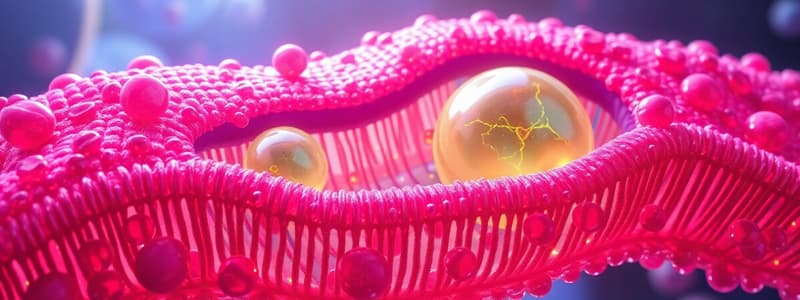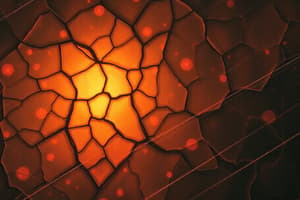Podcast
Questions and Answers
What is the primary function of the biomembrane in cellular biology?
What is the primary function of the biomembrane in cellular biology?
- To enhance the speed of RNA synthesis
- To act as a selective barrier for cellular activities (correct)
- To provide oxidative phosphorylation
- To facilitate DNA replication
Which lipid is considered essential for maintaining the fluidity of biological membranes?
Which lipid is considered essential for maintaining the fluidity of biological membranes?
- Saturated fats
- Triglycerides
- Phospholipids
- Cholesterol (correct)
In which model was the structure of cell membranes first proposed in 1972?
In which model was the structure of cell membranes first proposed in 1972?
- Lipid bilayer model
- D fluid symmetry
- Static composition model
- Fluid mosaic model (correct)
What are the two primary components of biological membranes?
What are the two primary components of biological membranes?
Which characteristic describes amphipathic lipids found in membranes?
Which characteristic describes amphipathic lipids found in membranes?
Which of the following correctly describes peripheral proteins?
Which of the following correctly describes peripheral proteins?
What type of interactions allows peripheral proteins to adhere to biological membranes?
What type of interactions allows peripheral proteins to adhere to biological membranes?
How do membrane proteins contribute to cellular functions?
How do membrane proteins contribute to cellular functions?
What mechanism primarily ensures the orientation of phospholipids in the biomembrane?
What mechanism primarily ensures the orientation of phospholipids in the biomembrane?
Which characteristic defines a selectively permeable biomembrane?
Which characteristic defines a selectively permeable biomembrane?
What is the nature of the extracellular matrix (ECM)?
What is the nature of the extracellular matrix (ECM)?
Which cellular processes might depend on the composition of the lipid bilayer?
Which cellular processes might depend on the composition of the lipid bilayer?
Which of the following transport mechanisms does not require energy?
Which of the following transport mechanisms does not require energy?
What is the primary driver for the movement of substances during simple diffusion?
What is the primary driver for the movement of substances during simple diffusion?
Which type of substance can typically pass through the membrane via simple diffusion?
Which type of substance can typically pass through the membrane via simple diffusion?
What is the fluid mosaic model primarily used to describe?
What is the fluid mosaic model primarily used to describe?
What is the main driving force behind the formation of the lipid bilayer?
What is the main driving force behind the formation of the lipid bilayer?
Which structural feature is true regarding the lipid bilayer?
Which structural feature is true regarding the lipid bilayer?
Which of the following contributes to the structural integrity of biological membranes?
Which of the following contributes to the structural integrity of biological membranes?
What role does cholesterol play in biological membranes?
What role does cholesterol play in biological membranes?
Which type of proteins are known to be embedded within the lipid bilayer?
Which type of proteins are known to be embedded within the lipid bilayer?
In the fluid mosaic model, which statement accurately describes membrane dynamics?
In the fluid mosaic model, which statement accurately describes membrane dynamics?
Which carbohydrates are common in membrane glycoproteins?
Which carbohydrates are common in membrane glycoproteins?
What is the effect of the hydrophobic interactions on the lipid bilayer?
What is the effect of the hydrophobic interactions on the lipid bilayer?
Flashcards are hidden until you start studying
Study Notes
Peripheral Proteins
- Located on the outer regions of the lipid bilayer of cell membranes.
- Attach to the membrane through a combination of hydrophobic, electrostatic, and other non-covalent interactions.
Extracellular Matrix (ECM)
- A flexible and sticky layer covering the surface of cells.
- Composed of complex carbohydrates, proteins, and lipids.
- Cell-specific, meaning its composition varies between different cell types.
- Involved in cell-cell recognition and communication.
- Facilitates cell adhesion.
- Provides a protective outer layer for cells.
Biomembrane: Selectively Permeable
- A key characteristic of biomembranes is their selective permeability.
- This allows for effective separation of a cell or organelle from its surroundings.
Transport Across the Plasma Membrane
- Passive Transport: Movement of substances across the membrane without requiring energy.
- Simple Diffusion: Substances move through openings in the membrane.
- Facilitated Diffusion: Substances move with the help of carrier proteins.
- Active Transport: Movement of substances across the membrane against an energy gradient, requiring energy.
- ATP-driven pumps: Use ATP hydrolysis to drive transport.
- Light-driven pumps: Utilize light energy to transport substances.
- Coupled transport: The movement of one substance is coupled to the movement of another.
Osmosis
- The passive diffusion of water across a semi-permeable membrane.
- Water moves from a high concentration (low solute) to a low water concentration (high solute).
Transport by Simple Diffusion
- Unassisted movement of a substance through a membrane.
- Driven by the force of diffusion.
- Facilitated by the hydrophobic nature of the substance, allowing it to pass through the hydrophobic core of the membrane.
- Examples include CO2, O2, and ethanol.
Functions of a Biomembrane
- Surround cells (Plasma Membrane).
- Surround distinct subcellular compartments (e.g., nucleus, mitochondria, lysosomes, Golgi bodies).
- Compartmentalize and segregate intracellular events.
- Separate cells from each other.
- Regulate cellular functions:
- Acting as selective barriers.
- Allowing the inside environment of cells or organelles to differ from the outside.
Major Lipids in the Biomembrane
- Phospholipids
- Glycolipids
- Cholesterol
- Lipids in membranes are amphipathic, meaning they have both hydrophilic (water-loving) and hydrophobic (water-fearing) regions.
- This orientation helps to prevent the hydrophobic region from interacting with water molecules.
Amphipathic molecules
- Have both a hydrophilic and a hydrophobic region.
- This dual nature allows them to interact with both water and non-polar environments.
Micelle
- A spherical structure formed by amphipathic molecules in water.
- The hydrophobic tails of the molecules are oriented towards the center of the micelle, while the hydrophilic heads face the surrounding water.
Cell Membrane Structure - Fluid Mosaic Model
- The most widely accepted model of membrane structure.
- Postulated by Singer and Nicholson in 1972.
- The phospholipids of membranes are arranged in a bilayer, forming a fluid crystalline matrix.
- The lipid molecules can move laterally within this matrix, contributing to membrane fluidity and flexibility.
- The bilayer is relatively impermeable to highly polar molecules.
- The components of the membrane are free to diffuse laterally, meaning the mosaic is not fixed or static.
Phospholipid Bilayer
- Formed by the arrangement of phospholipid molecules in a bilayer structure.
- Each phospholipid molecule has two non-polar (hydrophobic) fatty acid chains (tails) and one polar (hydrophilic) head group.
- In water, the hydrophobic tails pack together in the interior of the bilayer, while the hydrophilic heads face the aqueous environments on either side.
- The bilayer has two leaflets: an inner and an outer leaflet.
Maintaining Structural Integrity of Biological Membranes
- The primary driving force for the formation of a lipid bilayer is the hydrophobic effect, where hydrophobic fatty acid chains avoid contact with water.
- The structure is maintained by multiple non-covalent interactions:
- Hydrophobic interactions.
- Van Der Waals forces between hydrocarbon chains.
- Hydrogen bonding between polar head groups.
- Hydrogen bonding between head groups and surrounding water molecules.
Components of Biological Membranes
-
Cholesterol:
- A steroid found in most membranes.
- Does not form bilayers but dissolves in the lipid layer.
-
Glycoprotein:
- A protein containing carbohydrate chains.
- Usually face the exterior of the cell.
- Contain sugars like mannose and galactose.
- Various combinations of sugars result in different antigens, which are used as signals to distinguish different cells.
-
Integral Protein:
- At least one segment anchored within the lipid bilayer.
- Many contain sequences of about 20 hydrophobic amino acids that fold into a hydrophobic α-helix embedded in the lipid bilayer.
Studying That Suits You
Use AI to generate personalized quizzes and flashcards to suit your learning preferences.




